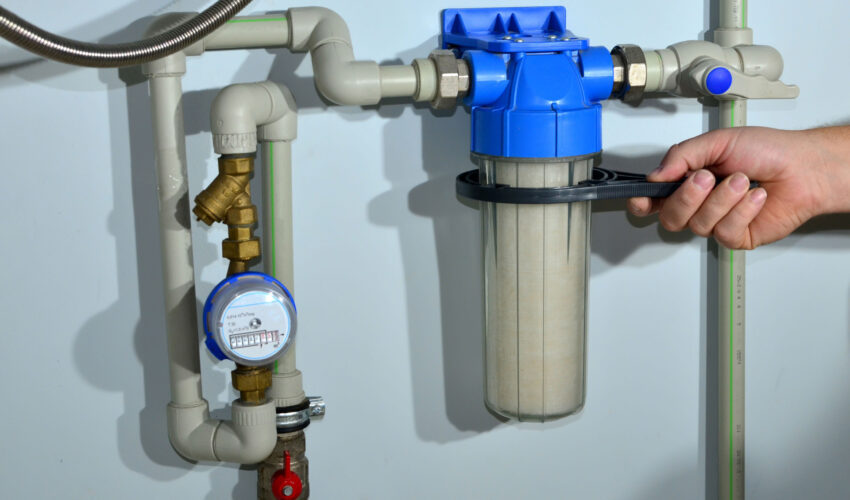As a homeowner in San Antonio, you may rely on a whole house water filtration system to filter out contaminants and impurities and provide your home with clean, fresh, great-tasting water. Like any appliance, water filtration systems can develop problems over time. However, for every problem that arises, there exists a suggested solution.
Understanding the Process
To identify problems, you first need to understand the water filtration process. Simply put, water flows through an inlet on the water housing cap, into the water filter housing, which holds the filter cartridge in place, and through the filter. From there, purified water flows out of the housing, through the cap’s outlet, and into your home’s pipes. Between each connection you can typically find o-rings, round elastic gaskets that help seal the system.
Issue 1: Bad Smell or Taste
Water filters are designed to improve the taste and odor of your water by removing contaminants – but when the filters become loaded with contaminants, they can no longer remove impurities that make your water taste or smell unpleasant. Due to the ultra-hard water in San Antonio, homeowners may need to replace filters more frequently than suggested. If you notice your home’s water quality degrading, it is likely time to change out your water filter.
Issue 2: Poor Water Pressure
Although there are a wide variety of factors that can lead to poor water pressure, one place to consider is your filtration system. Clogged filters or a wrong-sized system can cause pressure issues:
- Wrong-sized systems: The size of your filter housing is based on the flow rate necessary for your home. Smaller filtration systems, such as a point-of-use filter, will have lower flow rates, which means, if sized incorrectly, your water pressure won’t be up to par. If you feel the size of your system is the issue, call a professional to review your water needs.
- Clogged filters: As explained above, contaminants may clog your filter, preventing proper filtration and restricting water flow. Your manufacturer may either recommend cleaning and reusing the filter cartridge or a complete filter replacement.
Issue 3: Stuck Filter Housing
You may struggle to loosen your system’s filter housing during a filter change due to over-tightening during installation, mineral deposits left behind by hard water, or forgetting to depressurize your system.
- Depressurize your system: Before conducting any troubleshooting, it’s crucial to release the pressure in your system to prevent injury. Though you should always check the manufacturer’s guide for information specific to your system, there are many how-to video resources available.
-
- Remember that whenever you depressurize your system, air will enter causing your water to come out in spurts. This is normal – let the water from your faucet run fully for a few minutes until the air is out and water is flowing smoothly again.
- Use a filter wrench: Filter wrenches fit around your filter housing and are great at providing the extra leverage you may need to loosen a stubborn filter housing.
Issue 4: Leaking
One of the most common water filtration issues we see is leaking. There are two common causes of leaking: improper installation and normal wear and tear. Whether you notice water coming from your system or see puddling beneath it, you’ll need to locate the source of the leak. There are a couple key spots to check:
- Filter Housing: First, be sure your system is correctly installed and all connections are tight, but not overtightened. If you suspect your housing is installed incorrectly, try unscrewing and rescrewing your filtration housing from the cap to see if that fixes the issue. Because the filter housing holds water and spilling may occur, dry the housing off before checking for leaks.
If it’s not an installation problem, check for wear and tear. Although filter housing is made to flex with the changing pressure that occurs with water usage, as your system ages, the body of your filter housing can crack. Attempting to seal these leaks could void your warranty. In these cases, it’s best to replace your water filter housing as a whole.
- O-rings: Regularly check the seals between the connections of your system for damage. Often, identifying a worn seal can be as simple as a visual inspection; seals are designed to be watertight, so any cracks, pits, wrinkles, or peeling of the o-ring can be a sign that your seal isn’t working as it should. To keep your o-ring in optimal condition, consider applying a sealing lubricant when screwing connections back into place.
In Conclusion
Whole house water filtration systems are an essential part of maintaining clean water in your home. But like any system, they can encounter issues over time. At North East Air Conditioning, Heating & Plumbing, our experienced technicians can install, troubleshoot and repair whole house water filters. Just give us a call at (210) 658-0111 or visit our website to schedule an appointment and get back to enjoying clean, safe, and delicious household water.
Photo by Maksim Safaniuk


